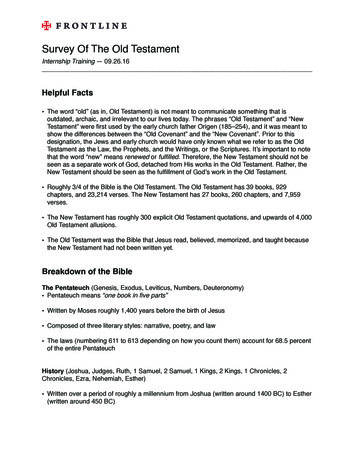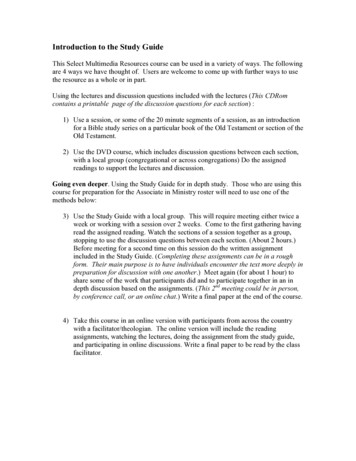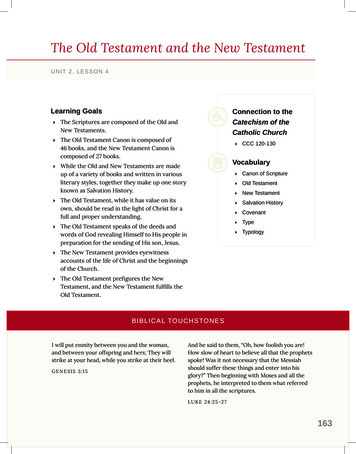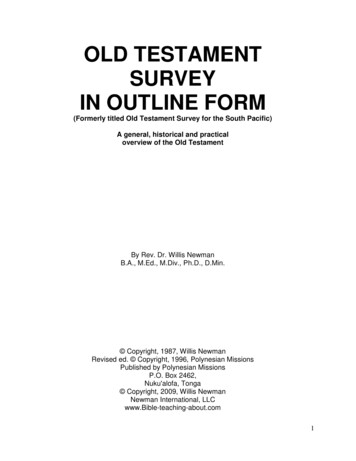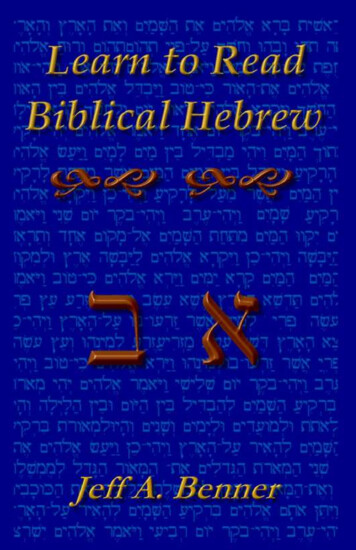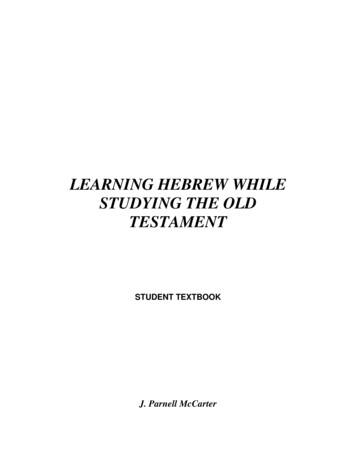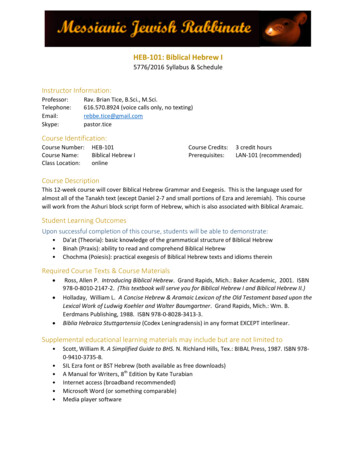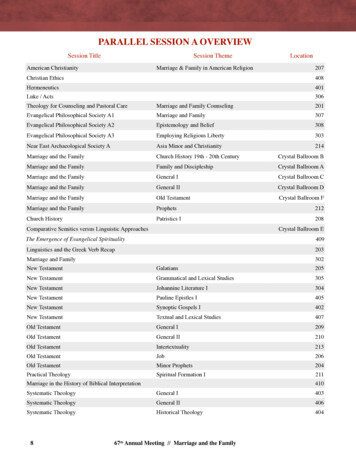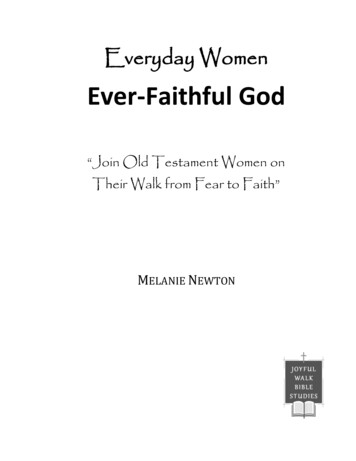
Transcription
Year I: Old Testament (Hebrew Bible)131-18A
Society of St. AndrewVacation Bible School Mission Giving Report We used: Year 1, Old Testament Year 2, New TestamentChurch name:Church address:City, State, Zip:Average # Participating ChildrenMissions Giving Total Contact Person:Your Role in VBS This Year:Phone:Email:Please print and return this form with a single check for the total amount of yourcongregation’s VBS mission giving to:Society of St. Andrew 3383 Sweet Hollow Road Big Island, VA 24526We will respond with a personalized certificate to show our thanks and appreciation for your VBS donations.All donations are used to feed hungry people right here in the USA! You and the children are a vital part ofthis process!We’d love to hear from you! Write us a note on the back of this form, add your pins to our VBS Pinterest board atpinterest.com/endhungerusa, or call Betty Easter, Director of Church Relations at 800-333-4597, or write Betty atchurch@EndHunger.orgiiThe Society of St. Andrew is an IRS 501(c)(3) nonprofit and is registered with all applicable state agencies throughout theUnited States to solicit charitable contributions. Required charitable solicitation compliance information can be foundhere: endhunger.org/compliance
Abundance Orchard – Year 1 (Old Testament)Making the Best Use of this MaterialYou are used to seeing separate booklets, labeled for each of your leaders. In this no-frills VBS, you havereceived a single packet. Here’s how to put these materials to work!FOR YOUR PLANNING TEAM: Copy the entire packet for each team member ORProvide each team member a link to the entire packet dfORHole-punch the entire packet, and put it in a three-ring binder. Place the binder in a location where allteam members can review and use it.You may wish to add a 10-tab divider set. (Avery #11134, #11135, or #11188, available fromStaples. Check Staples.com for current pricing.) Here are labels and a list of pages to include ineach section.12345678910Introductory MaterialsPlanning HelpsBible nArts and CraftsNotesPocket 1Pocket 2pp. 2-4pp. 5-12**Add your daily schedule page here**Add your leader roster herepp. 13-14, 18-19, 24-25, 30-31, 36-37pp. 15-17, 20-23, 26-29, 32-35, 38-40pp. 41-46pp. 47-50pp. 51-53pp. 54-56pp. 57-69**Extra paper you addp. 70 and Reproducibles5 Mission Pictures & StoriesFor ALL Leaders:Copy the following pages, placing in a folder or binder:CoverScope & Sequence (p. 4)Leaders (pp. 5-6)Daily Schedule (YOU create this)Leader Roster (YOU create this)Day 1 – Day 5 (pp. 13-38)Task-Specific Pages (See Below)Society of St. Andrew Info SheetSociety of St. Andrew Pictograph StoryMission Stories (p. 43)Sheet with Pinterest Link: le-schoolAND Website Link: http://www.endhunger.org/vbs
Task-Specific Pages for Leaders:For Shepherds:For Missions Leaders:For Music Leaders:For Snack Leaders:For Recreation LeadersFor Arts & Crafts Leaders:For Artists & Scene Makers:nonepp. 41-46pp. 47-50pp. 51-53pp. 54-56pp. 57-69pp. 10-12If Preschool Children will have Bible stories and activities in their classroom, copy these task-specificpages for Preschool Leaders:pp. 41-46 (Mission), pp. 54-56 (Recreation), pp. 57-69 (Crafts)BELOW is a half-sheet you can copy for all leaders, with the Pinterest and Website links foradditional suggestions and -----------------Abundance Orchard Vacation Bible SchoolSociety of St. AndrewNeed more ideas? Need brighter colors? Want some excitement and frills?Check out the Abundance Orchard Pinterest on-bible-schoolWant to learn more about the Society of St. Andrew? Need some more photos orstories for Vacation Bible School? Check out the EndHunger.org website!http://www.endhunger.org/vbs
2Table of Contents3Introduction4Scope & Sequence5Leaders7Schedule10Backdrops & Scenery12Mascots & Characters13Day 1 – Hospitality Abraham & Sarah prepare a meal for unexpected guests13Background & Reflection Questions15Sharing the Bible Story18Day 2 – Trickery Esau sells his birthright for a bowl of stew18Background & Reflection Questions20Sharing the Bible Story24Day 3 – Obedience The Hebrew people eat a quick meal before leaving Egypt24Background & Reflection Questions26Sharing the Bible Story30Day 4 – The Miraculous God provides manna and quail in the desert30Background & Reflection Questions32Sharing the Bible Story36Day 5 – Hunger A poor mom shares her food with Elijah36Background & Reflection Questions38Sharing the Bible Story41Missions: Society of St. Andrew47Music51Snacks54Recreation57Arts & Crafts70Reproducibles and Mission StoriesAbundance Orchard: Where Faith Grows and Hungry People are Fed 2014, Society of St. Andrew. Permission granted to copy resources for congregational use.No fees may be charged for the distribution of these materials.Society of St. Andrewgleaning america’s fields feeding america’s hungry3383 Sweet Hollow Road Big Island, VA 24526 800-333-4597 church@endhunger.org
3Abundance Orchardwhere FAITH grows and hungry people are fedXThis Vacation Bible School material is provided to your congregation free of chargefor your use in sharing faith with children and young people and to promote the feedingprograms of Society of St. Andrew.Permission is granted to copy any of these Vacation Bible School resources in whateverquantities you need for your congregation’s use. Please keep all copyright informationintact on copied pages.We ask you to collect mission offerings at every session of your Vacation BibleSchool and to designate these offerings for Society of St. Andrew. Every 3 given willput one serving of healthy, nourishing food on the plate of a hungry person here in theUnited States. In this packet of materials, you will find more information about Society ofSt. Andrew and suggestions for promoting the mission offering and setting an offeringgoal.Abundance Orchard is designed as a stand-alone, no frills Vacation Bible School,with up to five sessions, lasting 2-3 hours each, for older preschool and elementary-agedchildren. You will find plenty of suggestions for activities, stories, and service, allfurthering each lesson’s theme. You’ll note that there are no gimmicks or gadgets ordisposable, easily breakable items here. Society of St. Andrew strives to be a goodsteward of financial and environmental resources, and we know that for manycongregations, traditional VBS materials can be cost-prohibitive. This curriculum caneasily be adapted for use in Sunday Schools using the Rotation Model.Year 1 Curriculum is focused on stories about food and eating in the Old Testament(Hebrew Bible). Each day’s program is based on a different scripture passage andincludes a thematically-connected memory verse.NEW!. New with this curriculum are daily questions for preparation and reflection onthe day’s scripture passage. These questions are designed for VBS teachers and leaders,as a means of deepening faith through interaction with the scripture. You may also wishto use these questions as the basis for a daily VBS-connected Bible study for older youthand/or adults, lasting 60-90 minutes.NEW!. Even more VBS help on SoSA’s VBS Pinterest Board – visit for inspiration,sources, alternative ideas, and on-bible-school/
4Abundance OrchardYear 1: Scope and Sequence Hospitality Genesis 18:1-15 Abraham and Sarah prepare a meal for unexpected guests Is anything too wonderful for God? (Gen. 18:14a) Trickery Genesis 25:29-34 Esau sells his birthright for a bowl of stew Teach us to count our days, that we may gain a wise heart. (Ps. 90:12) Obedience Exodus 13:3-10 The Hebrew people eat a quick meal before leaving Egypt Do not fear, for I am with you. (Is. 43:5a) The Miraculous Exodus 16God provides manna and quail in the desert Hunger I will sing of your steadfast love, O Lord, forever. (Ps. 89:1) 1 Kings 17:8-16A poor mom shares her food with Elijah You shall eat plenty and be satisfied and praise the name of theLord. (Joel 2:26a)Bible Story Memory verse
5JLeadersNo matter what size your congregation or VBS is, you simply need a lot of leaders!It’s best to start the process with a planning team, meeting as early in the calendar year asyou can manage. This planning team could be your whole church board, your ChristianNurture team or Christian Education Committee, a special ad hoc VBS task force, orsimply a few friends who get together to start thinking about VBS.Very early in the planning, this team needs to identify someone to be in charge ofVBS, the VBS Director. This person is responsible for all the details, for seeing thatmaterials and supplies are ordered, that publicity is done, that staff is recruited andtrained, etc.you recruit your VBS director, don’t downplay the amount of work Wheninvolved and do offer lots of support!out whether your congregation’s policy requires that all teachers, leaders, Find and staff be members of the church and whether there is a time restriction (active members for six months or a year, etc.) Are there minimum agerestrictions?your congregation’s Child Protection policy / Safe Sanctuary policy in Follow recruiting VBS staff. This is non-negotiable. Get the paperwork filled out forperson and do the background checks required by your congregation’s eachpolicy. However large or small your congregation or your VBS, wherever you congregation is located, child safety is paramount!for at least three people (two unrelated adults and one teen helper or Planadditional adult) to be with each group of children at all times.Decide whether your VBS will be primarily classroom-based or primarily centerbased. (See below.) A classroom-based VBS needs teachers who can do a little bit ofeverything, from storytelling to recreation to crafts and crowd control. A center-basedVBS needs leaders with specific interests and expertise: some who love caring for andabout children, some who are great with games and recreation, some who are crafty,some who are creative in the kitchen, some who tell stories, etc. Once this decision ismade, you can recruit staff for specific responsibilities.
6Center-Based VBSShepherdsMany Vacation Bible Schools have adults serving as classroom “shepherds,”providing care and continuity for children throughout the week of VBS, but withoutspecific teaching responsibilities. All activities (Bible, Crafts, Music, Recreation, Snacks,Missions) are center-based, with each center in a different area of the building, soshepherds accompany the children to the center-based activities and provide extra handsand crowd control throughout the VBS day. This takes more leaders overall, but offersleaders the opportunity to focus in an area of greatest interest to them.Modified ShepherdsOther Vacation Bible Schools modify the “shepherd” concept by having theshepherds lead the Bible storytelling segment for their assigned group each day, thenaccompany the children to their other, center-based activities.Center LeadersCenter leaders are responsible for one activity only: recreation, snacks, missions,crafts, music, opening, or closing. They are responsible for this “center” each day ofVBS. Children of all ages may rotate through their center in age-based groups, so theymay have to plan adaptations for each day’s activity for children of varying abilities.Classroom-Based VBSStill other Vacation Bible Schools use the “traditional” classroom model. These haveteachers and assistants who handle all aspects of the VBS day in a classroom setting.Possibly music, recreation, or snacks will be center-based and led by others. This uses thefewest leaders, but may create logistical issues for resources, if all the scissors or balls arebeing used by another class, for instance.Many Vacation Bible School directors prefer a classroom-based model for preschooland kindergarten classes, but a center-based model for elementary classes.
7 ScheduleWhat Dates Should VBS Be Held?For many school districts, summers are shorter and shorter each year. In some places,children of a single congregation may attend schools of multiple districts or with varyingcalendars. How do you choose the best dates?Considerations:1. Define your audience. Are you targeting just/primarily school-aged children (K-Gr. 5,for example) as participants, or will you have class(es) for preschoolers as well? Whatabout middle schoolers/junior highs, senior highs, and adults? Is this primarily anextra Christian Education opportunity for those within your congregation, or do youhave a strong commitment to evangelism, bringing in children/families from thelarger community?2. Are there transportation issues to be addressed?3. When are children/participants potentially available? Look at all the school calendarsand settle on 3-4 weeks, if possible, when every child who might attend is actuallyout of school.4. Are there other Vacation Bible Schools in the area serving the same populations? Ifso, then you need to be sure that your VBS weeks are staggered (and that you’reusing different curricula) OR you need to think seriously about combining forces fora multi-congregation VBS effort.5. When are your key leaders actually available? Look at your pool of key leaders, andfind out which of those 3-4 possible weeks they are available. You might consider afree calendar survey tool like Doodle (doodle.com) to simplify the process.6. Which one of your best options for key leaders is also best for potential staff (adults& teens) and children most likely to participate? If you can narrow your choice to justtwo weeks and/or two timeframes that work for your leadership team, then run yoursurvey again, notifying all in your congregation and neighborhood for their input.7. Realize from the outset that not everyone will be able to participate in VBS each year.Assure yourself that you are making the best possible effort to be inclusive.Options:You have LOTS of options! Here are just a few: Five days (Sunday – Thursday or Monday – Friday) Four days (Monday – Thursday) Four or five days big celebration Morning, afternoon, or evening
8 One morning or evening a week for five weeks (or more)As part of a summer camp / summer day care / conference / retreatOne two-day weekendA single long daySummer Sunday SchoolSpring Break or Fall BreakWinter Break (week between Christmas and New Year’s)What Time Frame is Best for VBS?Morning has been the “traditional” VBS time slot, with 9am-12noon, 9:30am12noon, or 9am-11:30am being the most common schedules. If most adults in yourcommunity work outside the home, this can be a difficult VBS schedule. Othertimeframes may work better for your situation.When congregations choose an evening format for VBS, it is usually because thateases potential issues for adult leadership (work) and for parents (work/transportation). Itis also a better choice if you are looking at whole-family VBS or whole-congregation(youngest to oldest) VBS. Often evening VBS formats necessitate considering a dinner orsnack supper as the first segment of VBS. Some congregations offer a snack supper at5:30pm, with VBS starting at 6pm; or snack supper at 6pm, with VBS starting at 6:30pm.It’s rarely realistic to plan for VBS to end after 8pm, so you may have to offer acompressed schedule, limiting activities – perhaps cutting out recreation and a separatesnack time within the evening.An evening format is difficult for preschoolers, so families including preschoolersmay simply opt out, just because it is too disruptive to family routine.Afternoon is generally a lower-energy time for children and adults alike.Preschoolers often take afternoon naps. Unless VBS is part of a summer camp or daycareor needs to follow a morning sports or community-based program that serves most of thesame children as your VBS, afternoons are seldom the optimal choice.In hotter climates, you’ll want to limit outdoor time in the middle of the day.We will hold Vacation Bible School on the following dates:Our schedule will be:
9How Should the Daily Schedule Flow?Sample Schedule: Three‐hour morning VBS20 min. All‐VBS OpeningGreeting, Songs, Mascot introduces Bible story for the dayMission offerings received, Prayer, Dismissal to age-basedgroups30 min. BibleDiving into the Bible story through interactive learning30 min. CraftsAge-appropriate craft activities that support the Biblestory and/or missions emphasis of VBS20 min. MusicMusic & movement activities30 min. RecreationActive games and structured activities that support theBible story and/or missions emphasis of VBS15 min. SnacksFoods that connect with the Bible story and missionsemphasis20 min. MissionsMissions story and activity15 min. All‐VBS ClosingMascot re-caps the day, missions giving totals announced,announcements & info for next day, final song, prayerSample Schedule: Snack supper 90 minute evening VBS30 min. Snack SupperEither a sit-down or buffet style meal, or a grab & go heavyfinger-food type snack30 min. BibleDiving into the Bible story through interactive learning30 min. CraftsAge-appropriate craft activities that support the Biblestory and/or missions emphasis of VBS15 min. MissionsMissions story and activity15 min. All‐VBS ClosingMascot recaps day, Mission offerings received,Announcements & info for next day, Music, PrayerThe line to the left of certain activities (above) indicates that, for a center-based VBS,classes will be rotating among centers during this time.Rotation schedules require a little more logistical coordination!
10A Backdrops and SceneryGathering Area / Lobby / Worship AreaMany congregations like to decorate their building or worship area for Vacation BibleSchool. This is “Abundance Orchard,” so an orchard theme would certainly beappropriate!Use the Abundance Orchard logo as your inspiration to create a backdrop ofcardboard fruit trees, painted with tempera paints. Add a short stepladder or stepstool andsome wooden fruit baskets or crates. Green indoor-outdoor carpeting or bathmats cancreate the “ground” under the trees.The Society of St. Andrew’s mission is recovering fresh fruits and vegetables that justdon’t quite meet the market standards – fruit that is too big or too small, the wrong shapeor size or color, or perhaps has too many blemishes to be sold in the grocery store. Withthat in mind, invite people in your congregation to empty their mis-matched sock drawersand donate their clean used socks to your VBS. Colors, patterns, whatever! Roll eachsock into itself and mold it with your hands to create “fruit” for your baskets, crates, andtrees.and black socks might be slightly less useful as “fruit,” but these can Whiteeasily be saved and re-purposed for other crafts during the coming months. VBS, put all the sock “fruits” into a bin or tote and save them for Afterrecreation activities in the future.Designate one backdrop tree as your “missions” tree. Pin, tape, or tuck one piece of“fruit” (either sock fruit or construction paper fruit) on this tree for every dollar (or 5 or 10, depending on your missions offering goal and the size of your VBS) the VBSchildren donate to feed healthy food to hungry people through Society of St. Andrew.Watch the tree grow full of fruit as you move through the days of VBS!Bible Storytelling AreaAll of this year’s stories come from the Hebrew Bible (Old Testament). The story ofAbraham and Sarah (Day 1) takes place in a desert-like setting. Abraham and Sarah livein a large tent. Jacob and Esau (Day 2) live in an arid climate, possibly in a large tent, butperhaps in a still-primitive, but more permanent structure. The Hebrew people (Day 3)are leaving homes and heading quickly into the wilderness. On Day 4, the Hebrew people
11are in the wilderness/desert, without shelter. On Day 5, Elijah goes to the home of theWidow of Zarephath.For scenery purposes, then, you’ll want a sky and desert-like backdrop, perhaps withsome scrub brush painted at ground level and some distant hills. In front of the backdrop,place some large boulders (crushed newsprint, painted gray/tan) and some largecardboard water jars, painted a sandy clay color. This portion of the scene will remain thesame throughout VBS.For Day 1, make a tent out of tan, green, or gray bedsheets and blankets. This can benearly flat, so that it fastens to the backdrop, or you could make it drape between twosawhorses and a step ladder or two. You might add a bright spotlight, to portray the heatof the midday sun.For Day 2, Day 3, and Day 5 add a cardboard home: square-ish, painted a sandycolor, with a flat roof and a doorway, with a towel or sheet hanging behind the doorway,to serve as the door.For Day 2, add a rustic table and chair in front of the home and perhaps a log“cookfire” with a cooking pot suspended over it.On Day 3, add construction paper “blood” to the doorframes of the home. Remove itprior to Day 5.For Day 4, use only the backdrop.For Day 5, the scene should be as on Day 2, though you may wish to add a “well” (acircle of crushed newspaper boulders) to the outside of the house.A sample backdrop pattern is included as part of this packet. Visit SoSA’s VBSPinterest page for more vacation-bible-school/
12oVBS Mascots / CharactersConsider having an older youth or an adult dress in costume each day as part of theopening and closing VBS activities. This costumed individual can be a non-speakingmascot, who simply acts as a cheerleader, increasing enthusiasm for VBS, or can be aspeaking character, who actually introduces the stories and memory verses each day ofVBS.You can purchase a costume, rent a costume, or invite a creative soul to make one foryour VBS mascot/character.Suggested Mascots / Characters Sally the Spud Kerry the Carrot Robbie the Rutabaga Asa the Asparagus Farmer (name) Tomás the Tomato Gary the Grape Patrice the Peach Omar the Orange
13 Hospitality Genesis 18:1-15Abraham and Sarah prepare a meal for unexpected guests Is anything too wonderful for God?(Gen. 18:14a)BackgroundHaving heard a call from God, Abraham has left his homeland behind. He becomes anomad, living in the wilderness, traveling gradually toward the land God has prepared forhim. Abraham is wealthy, with vast herds and flocks, and lives with Sarah, his wife,along with servants to tend the livestock and the home and with an extended family, inlarge tent homes, that they pack up and move seasonally to make the best grazing landand flowing water available.Abraham’s great sadness is that he has no children to carry on his family name. Bythe time of this story, Abraham is already an old man, and Sarah is an old woman.Here, at the hottest part of a very hot day, as Abraham is taking a break from his workand from the heat, three visitors suddenly appear in front of him. Culturally, Abraham isexpected to show hospitality, if only as a means of assessing whether the strangers arefriend or foe. As you might imagine, there are many levels of hospitality, ranging from adistant wave, to an invitation for visitors and their livestock to draw water fromAbraham’s stream, to allowing them to pitch their tents within the boundaries ofAbraham’s camp, even to welcoming the guests inside for a simple bowl of soup. ButAbraham’s hospitality goes beyond even this. Abraham bows before the visitors, agesture of servitude. He calls for a servant to bring water and wash their dirty feet andinvites them to rest under the shade of a tree. Abraham even offers a little bit of bread.And then Abraham does even more—he acts as though these are honored guests thathe has invited for a feast. He asks Sarah to bake yeast cakes with the finest flour, and hegoes out himself to the grazing land and chooses a tender calf, that he has a servant killand prepare for the guests. This is no quick snack supper! Yogurt and milk complete themeal, at which Abraham acts not as host, but as servant, standing near the table as thevisitors eat, so that he can better attend to their needs.As it turns out, the visitors are, indeed, messengers from God, who have come tobring the news that Abraham and Sarah will soon have a new baby—seemingly absurdand totally unexpected news that will change their lives forever.
14Preparation and Reflection for Teachers and Leaders How do you feel when you find strangers knocking on your door? How do yourespond in this situation? What “levels” of hospitality do you show to guests? How do you decide what degreeof welcome to offer particular guests? What joy and what worries, fears, or discomfort do you experience in welcomingguests to your home? What does hospitality mean to you? How do you demonstrate hospitality beyondsimply welcoming people into your home—what other kinds of hospitality are there? Can you recall a personal experience where either showing hospitality or being shownhospitality was transformative for you? Re-read Matthew 25:31-46. In teaching about the Last Judgment, Jesus describes amore radical kind of hospitality expected of his followers—“Truly I tell you, just asyou did it to the one of the least of these who are members of my family, you did it tome.” To whom is God calling you to demonstrate hospitality? How can you/will yourespond? Does showing hospitality require financial resources? How can one who has littleshow hospitality to others? Where do you find hospitality (and truth, and meaning) in this statement:“Christianity is one beggar telling another where to find food.” (D.T. Niles)xAbundance Orchard: Where Faith Grows and Hungry People are Fed 2014, Society of St. Andrew. Permission granted to copy resources for congregational use.No fees may be charged for the distribution of these materials.Society of St. Andrewgleaning america’s fields feeding america’s hungry3383 Sweet Hollow Road Big Island, VA 24526 800-333-4597 church@endhunger.org
15Bible Storytelling: Day 1Abraham and Sarah prepare a meal for unexpected guests.Genesis 18:1‐15See Backdrops & Scenery section of this Guidebook for suggestions for setting up aStorytelling Center. If you will have a Storytelling Center, consider having costumesavailable for the children to wear each day as you tell the story.Costumes for children should be very simple. You’re not putting on an elaborate play,just helping set the story’s atmosphere. Dig into the costume closet for yourcongregation’s Christmas play for tunics or bathrobes, or simply use lengths of plainfabric to drape over shoulders or to secure over heads with a stretchy headband or lengthof pantyhose knotted to fit a child’s head.The storyteller may wish to be more elaborately costumed, so that s/he can tell the Biblestory as an actual character in the story.Each day, the children will have a phrase or action that repeats throughout the story.Have a cue (pointing to children, a raised hand, etc.) that remains the same throughout theweek, so that the children know that, on that motion, they do the phrase or action.Today’s scene: A tent in the desert. Props: rocks, a well, a table, plates, a ladle, twobuckets of water, clean rags, a few towelsPhrase/action: Children fan themselves, act as though they are very hot and say, “Itsure is hot today.”Preparation:Read the Bible story thoroughly, so that you know it very well. Prepareyourself, using the Background and Reflection Questions for Day 1.Today, as the storyteller, you will be Abraham. The children will be theguests that you are welcoming on a hot day. Have available a small tubof dirt, some clean rags, two tubs of water, a ladle, and some towels.Telling the Story:(Walk into storytelling area and greet the children while standing. Ask the children tosit.) Oh, hello. My name is Abraham. I live here in the desert, because this is where Godhas told me to be. My wife, Sarah and I live in this tent. Though we’ve always wanted tohave children, God has never blessed us that way. And now we are quite old.How old do you think I am? (Accept & acknowledge children’s answers.) I am 90years old, and Sarah is 80. That is pretty old. Anyway, even though we are old, we seemto have a lot of stuff. Some people would even say I’m rich. Look out there. See all thosetents and all those animals? The goats and the sheep and the cattle? My workers live inthose tents, and all those animals belong to me. Usually I’m right out there with them,tending to the animals and making sure that all the outdoor work is going well, but right
16now I am taking a break. (CUE) “It sure is hot today.” Maybe I’ll just sit for a minute.(Sit, close eyes. Snore briefly.)(Sit up abruptly.) Oh, well. Would you look at that. (Peer toward children, with yourhand over your eyes, like a shade.) On a hot day like this, too. (CUE) “It sure is hottoday.” There are some people heading this way, and we are miles from anywhere.They’ve been traveling a long way. I bet they are dirty and tired and hungry and hot.(CUE) “It sure is hot today.”Here they are now, close enough that I can call out to them. (Yell toward children.)“Hey! Hey you! Come in out of the hot sun!” “You, sir, and you, ma’am, and you.” (Callthree children out of the group to join you. Ask them to take their shoes off and stomp inthe tub of dirt.)I’m Abraham, and I’m so glad you’ve stopped by. Welcome! Welcome to my humblehome. (CUE) “It sure is hot today.” Let me take your outer robes and, goodness, look atyour feet. Sit! Sit! Can I get you a drink of cool water? (Use ladle to scoop water forchildren.) Oh, and here. Put your feet in this nice tub of water. Let me wash them for you.(Use clean rags to wash and dry children’s feet. This will cause some giggling.)Will you stay for a little while? Just lie down here and rest for a few minutes. I’llhave Sarah, my wife prepare a little snack for you.(Sp
Year 1 Curriculum is focused on stories about food and eating in the Old Testament (Hebrew Bible). Each day’s program is based on a different scripture passage and includes a thematically-connected memory verse. .NEW!. New with this curriculum are daily questions for p
